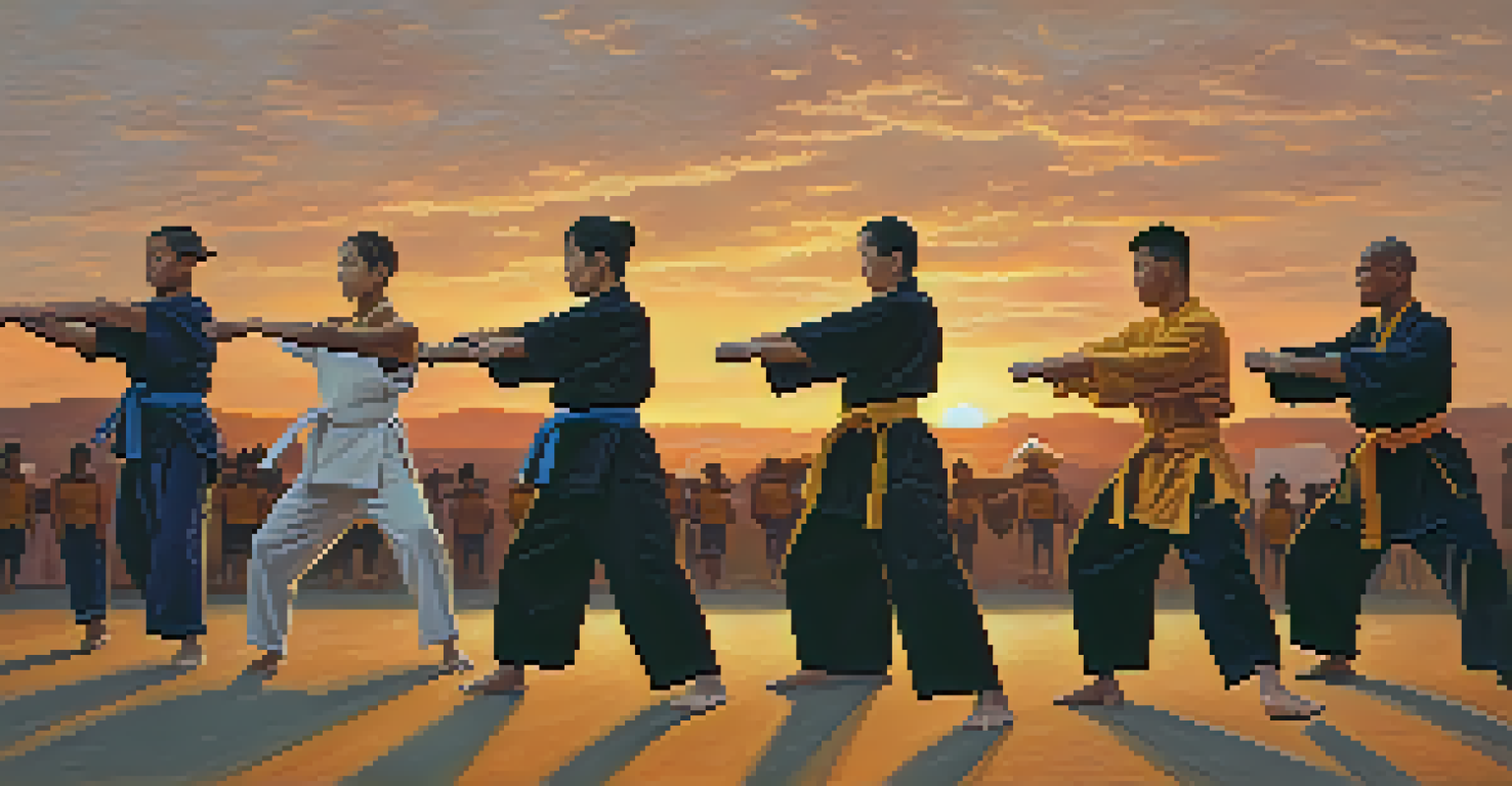Understanding the Mind-Body Connection in Martial Arts Training

What is the Mind-Body Connection in Martial Arts?
The mind-body connection refers to the relationship between mental processes and physical actions. In martial arts, this connection is crucial as practitioners learn to synchronize their movements with their thoughts. When you punch or kick, you’re not just using your body; you’re also engaging your mind to focus energy and intent into every move.
The body achieves what the mind believes.
This connection helps martial artists develop better control over their bodies, allowing them to perform techniques more effectively. For instance, a well-timed kick requires not only physical strength but also mental clarity to gauge distance and timing. Understanding this relationship can elevate your training experience and performance.
Moreover, a strong mind-body connection can enhance emotional regulation, helping martial artists stay calm under pressure. Whether in a sparring match or a competition, the ability to manage anxiety and focus on the task at hand can make all the difference in achieving success.
How Martial Arts Cultivates Mental Focus
Martial arts training requires a high degree of mental focus, which is essential for mastering techniques and strategies. As practitioners train, they learn to eliminate distractions and concentrate on their movements and breathing. This focused attention not only improves performance but also promotes mindfulness, a state of being fully present in the moment.

For example, during a kata (a pre-arranged sequence of movements), martial artists must pay close attention to their form and rhythm. This level of concentration can lead to a meditative state, enhancing both mental clarity and physical performance. Over time, this practice can help individuals carry their focus into other areas of life, improving overall productivity.
Mind-Body Connection in Training
Martial arts emphasizes the vital relationship between mental processes and physical actions, enhancing both performance and emotional regulation.
By incorporating mindfulness into their routines, martial artists can experience reduced stress and enhanced well-being. This practice is not just about physical fighting; it’s about cultivating a disciplined mind that can face challenges both in and out of the dojo.
The Role of Breathing in Martial Arts
Breathing plays a significant role in the mind-body connection, especially in martial arts. Practitioners learn to control their breath to enhance physical performance and mental state. Proper breathing techniques can provide the necessary energy to execute movements while also calming the mind during intense training sessions.
Your body can stand almost anything. It’s your mind that you have to convince.
For instance, many martial arts emphasize diaphragmatic breathing, which helps increase oxygen flow and promote relaxation. This technique not only fuels physical exertion but also grounds the practitioner, allowing for greater mental clarity and focus. As a result, martial artists can respond more effectively during sparring or competitions.
Incorporating breath control into training can lead to better emotional regulation as well. When faced with stressful situations, controlled breathing can help practitioners remain calm and centered, allowing them to make more thoughtful decisions and perform better under pressure.
Physical Training and Mental Strength Development
Martial arts training is not just about physical techniques; it’s also a powerful tool for developing mental strength. The rigorous practice builds resilience, discipline, and confidence, qualities that extend beyond the dojo. As practitioners face challenges, whether learning a new technique or sparring with a partner, they build mental fortitude that helps them tackle obstacles in daily life.
For example, overcoming the fear of failure during sparring can translate to increased self-confidence in various situations. Each small victory in training reinforces the belief that one can achieve goals through perseverance and dedication. This connection between physical effort and mental achievement is what makes martial arts so transformative.
Mental Focus Enhances Performance
Practitioners develop mental focus through training, which improves their technique and carries over to increased productivity in everyday life.
Furthermore, mental strength gained through martial arts can help individuals manage stress and anxiety. The skills learned on the mat—such as focus, control, and resilience—can be applied to everyday challenges, leading to a more balanced and empowered life.
Emotional Regulation Through Martial Arts Practice
Martial arts can be a powerful avenue for emotional regulation, offering practitioners tools to manage their feelings effectively. Training provides an outlet for stress, allowing individuals to release pent-up energy and frustrations in a controlled environment. This process can lead to a greater understanding of one’s emotions and how to navigate them.
For instance, the discipline required in martial arts encourages practitioners to face their emotions head-on rather than suppress them. Techniques such as meditation and visualization, often integrated into training, help individuals process their feelings and enhance emotional awareness. Over time, this practice fosters a sense of inner peace and stability.
Moreover, the supportive community found in martial arts schools plays a vital role in emotional well-being. Practicing alongside others who share similar goals creates a sense of belonging, which can be incredibly beneficial for emotional health.
The Importance of Visualization in Martial Arts
Visualization is a powerful mental technique often employed in martial arts training. By imagining successful performances, practitioners can enhance their physical abilities and reinforce their mind-body connection. This mental rehearsal allows individuals to mentally prepare for various scenarios and improve their confidence.
For instance, a martial artist might visualize themselves executing a complex move flawlessly before attempting it in practice. This process not only helps in refining technique but also reduces anxiety associated with performing in front of others. Visualization creates a mental blueprint that can guide physical execution.
Breathing and Visualization Benefits
Controlled breathing and visualization techniques in martial arts provide practitioners with emotional regulation tools and enhance their physical execution.
Incorporating visualization into daily practice can lead to improved outcomes in both training and competitions. This technique harnesses the power of the mind to influence physical performance, demonstrating the profound connection between mental imagery and real-world results.
Integrating Mindfulness into Martial Arts Training
Integrating mindfulness into martial arts training can significantly enhance the overall experience. Mindfulness encourages practitioners to cultivate awareness of their thoughts, emotions, and physical sensations during training. This heightened awareness leads to a deeper understanding of one’s body and mind, ultimately improving performance.
For example, by focusing on the sensations felt during a kick or a punch, martial artists can refine their techniques and learn to respond more intuitively. This practice fosters a sense of connection between the mind and body, enabling better control and execution of movements. Over time, this leads to a more fluid and effective practice.

Incorporating mindfulness exercises—such as meditation or breathwork—into training sessions can further enhance this connection. These practices help center the mind, reduce stress, and promote overall well-being, making martial arts a holistic approach to personal growth.